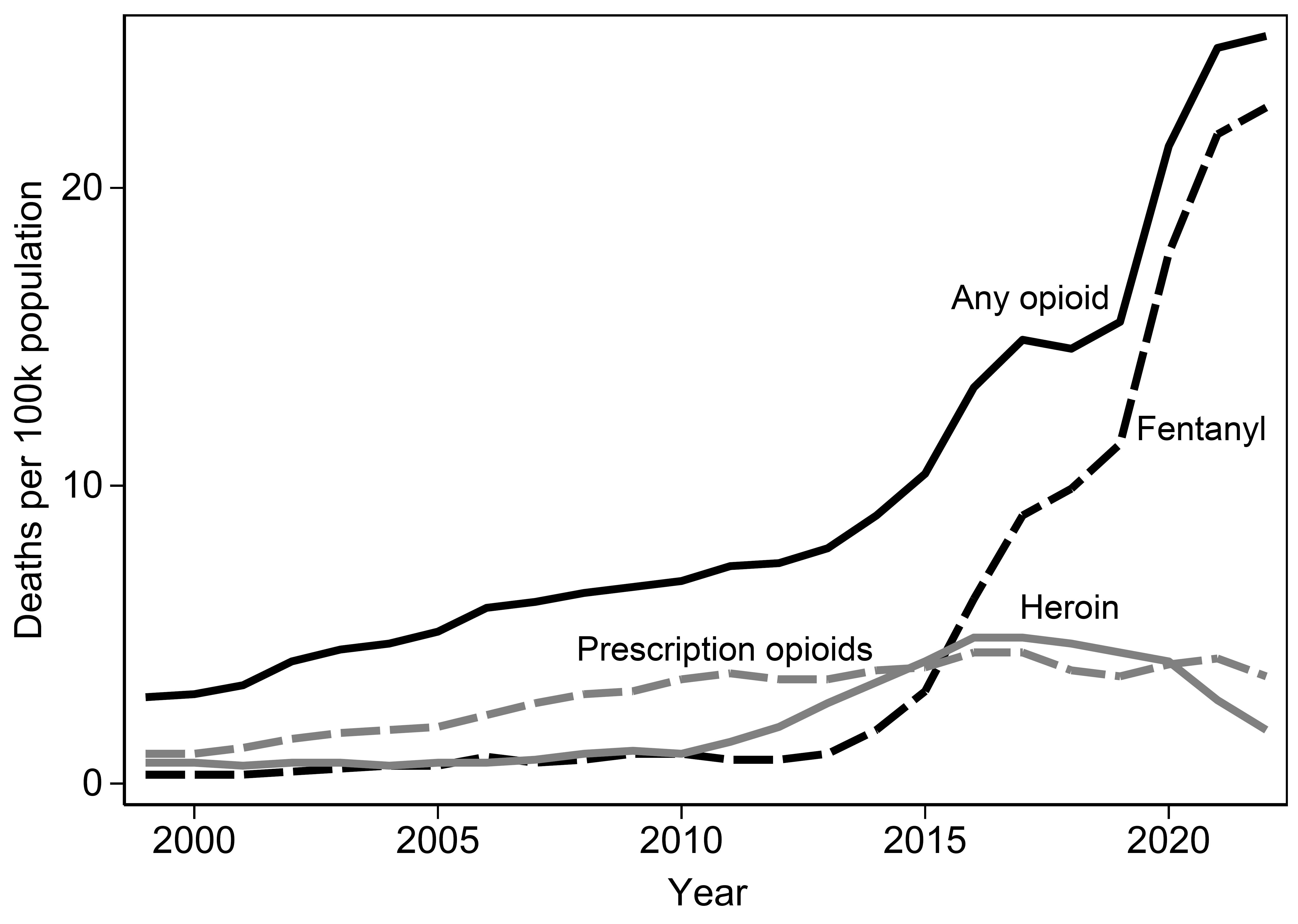Two important features of the opioid epidemic shape our understanding of the current situation. First, the opioid crisis has evolved in three phases (see Figure 1). The introduction of OxyContin and other powerful painkillers in the 1990s led to a tripling of deaths due to prescription opioids between 1999 and 2010 (Alpert et al. 2022). However, the reformulation of OxyContin and additional policy responses that limited the abuse of prescription opioids inadvertently triggered the second phase of the crisis, with deaths due to heroin quadrupling between 2010 and 2015 (Alpert et al. 2018, Evans et al. 2019). The third and most deadly phase of the opioid crisis has been the arrival of illicit fentanyl since 2013. Fentanyl deaths have risen quickly and they now account for 90% of all opioid overdose fatalities. Fentanyl is the leading cause of death for Americans aged 18-49, and more people now die from fentanyl than from traffic accidents and homicides combined. While fentanyl is clearly the driving force of the current opioid crisis, relatively little is known about this potent synthetic opioid (Simon et al. 2020, Maclean et al. 2022).
Figure 1 US opioid overdose deaths
Note: Authors’ calculation using data from the Multiple Cause of Death files and provisional overdose data from the National Center for Health Statistics.
The second key feature is that the geography of the opioid crisis has changed. The geographic distribution of non-fentanyl opioid overdose deaths is spread out and relatively constant over time, which is consistent with persistent demand for opioids due to factors like OxyContin marketing (Alpert et al. 2022, Arteaga and Barone 2023), ‘deaths of despair’ (Case and Deaton 2015), and job losses due to import competition (Pierce and Schott 2020). However, in Figure 2 we see that fentanyl deaths are highly concentrated in the Midwest and Northeast. This indicates that new supply-side factors may be important for understanding fentanyl (Glaeser and Cutler 2021). Furthermore, this geographic variation is inconsistent with common smuggling explanations, including airmail packages sent directly from China (which would lead to fentanyl deaths where existing opioid users were located) or transportation across the US-Mexican border (which would lead to fentanyl deaths in Southwest border states).
Figure 2 Fentanyl overdose deaths in 2017 (per 100,000 people)
Note: Authors’ calculation using data from the Multiple Cause of Death files and provisional overdose data from the National Center for Health Statistics.
Fentanyl smuggling via imports
Illicit fentanyl is being smuggled into the country, but little is known about how this is accomplished given the inherently secretive nature of drug trafficking. Policymakers speculate that trade supply chains may be used to smuggle synthetic opioids (Office of National Drug Control 2019). In our new paper (Moore et al. 2023), we examine whether there is empirical support for the idea that fentanyl is smuggled into the country using legal imports.
There is substantial state-level variation in imports, even between otherwise similar neighbouring states, which is typically driven by longstanding historical features. In Figure 3, we examine whether overdose death rates are related to this variation in state imports. The results show that before the fentanyl supply shock (2008-2012), opioid deaths in states with above- and below-median imports exhibited similar trends; in fact, there were slightly more deaths in low-import states than high-import states. However, the trends of these two groups diverge sharply after 2013. By 2017, opioid deaths in high-import states were approximately 40% higher than low-import states, with this divergence driven entirely by fentanyl deaths. In contrast, non-opioid deaths in low and high import states are virtually the same throughout this period (Figure 3). These patterns point to the possibility that fentanyl is being smuggled into the country via legal imports.
Figure 3 Drug overdose deaths in high and low import states
Note: This figure shows drug overdose trends for two groups of 25 states split by the median value of imports per capita over the 2008-2020 period.
Our empirical analysis examines the time-varying relationship between states’ imports per capita and the fentanyl death rate after controlling for state, year, economic, and demographic characteristics. The regression results in Figure 4 show that, prior to 2013, there was no relationship between imports and fentanyl deaths. However, after 2013, this relationship becomes increasingly more positive and statistically significant. By 2017-2020, 10% more imports per resident is associated with an 8.1% higher fentanyl death rate. Our estimates suggest that this relationship between imports and fentanyl overdoses can account for approximately 15,000-20,000 deaths per year over this period.
Figure 4 Relationship between fentanyl overdose deaths and imports
Note: This figure plots the estimated elasticities (and 95% confidence interval) between fentanyl overdose death rates per 100,000 people and the real value of imports per capita (relative to 2008).
We initially focus on total imports, because more imports from anywhere may decrease the probability of detection (Pitt 1981). However, additional results show that fentanyl deaths are related to a variety of specific import flows (that vary by country, mode, and product), which indicates that fentanyl smuggling is more diverse and pervasive than previously realised. Furthermore, we document a qualitatively similar relationship between imports and police seizures of fentanyl, which provides additional support for our smuggling hypothesis.
Other possible explanations
We explore whether our findings are driven by other possible explanations. First, we find that our results are not inadvertently capturing differences in population health across states by showing that there is no relationship between imports and other ‘deaths of despair’ (Case and Deaton 2015). Second, there is little relationship between imports and deaths due to other opioids, which indicates that we are not picking up broader trends in opioid demand. We also find that the relationship between imports and fentanyl deaths is not affected by accounting for import competition (Pierce and Schott 2020), OxyContin marketing efforts (Alpert et al. 2022), or proximity to the Mexican or Canadian borders.
Conclusions
Our paper provides new insights into the smuggling of illicit fentanyl, which is driving the most recent and deadliest phase of the US opioid crisis. Our findings suggest that fentanyl is being smuggled into the US via legal import flows, and that this has led to more drug overdose deaths in high-import states. These results highlight the value of using well-measured administrative data to provide insights into illicit drug smuggling. They also have important policy implications, suggesting a greater role for enhanced customs screening efforts and more funding for demand-side interventions like drug treatment in states more exposed to international trade. Our findings may also be of interest to policy makers in other countries, as they try to limit the arrival and devastating consequences of fentanyl and other synthetic drugs (Economist 2023).
References
Alpert, A, D Powell, and R L Pacula (2018), “Supply-side drug policy in the presence of substitutes: Evidence from the introduction of abuse-deterrent opioids”, American Economic Journal: Economic Policy 10(4): 1–35.
Alpert, A, W N Evans, E M Lieber and D Powell (2022), “Origins of the opioid crisis and its enduring impacts”, Quarterly Journal of Economics 137(2): 1139–1179.
Arteaga, C and V Barone (2023), “A manufactured tragedy: The origins and deep ripples of the opioid epidemic”, working paper.
Case, A and A Deaton (2015) “Rising morbidity and mortality in midlife among white non-Hispanic Americans in the 21st century”, PNAS 112(49): 15078–83.
Economist (2023), “Fentanyl kills thousands every year in America. Will Europe be next?”, 16 November.
Evans, W N, E M Lieber and P Power (2019), “How the reformulation of OxyContin ignited the heroin epidemic”, Review of Economics and Statistics 101(1): 1-15.
Glaeser, E and D Cutler (2021), “Understanding the opioid epidemic: When innovation fails”, VoxEU.org, 12 July.
Maclean, J C, J Mallatt, C J Ruhm and K Simon (2022), “The opioid crisis, health, healthcare, and crime: A review of quasi-experimental economic studies’, Annals of the American Academy of Political and Social Science 703(1):15–49.
Moore, T J, W W Olney and B Hansen (2023), “Importing the opioid crisis? International trade and fentanyl overdoses”, NBER Working Paper No. 31885.
Office of National Drug Control (2019), “21st Century Drug Trafficking Advisories on Fentanyl and Other Synthetics”, 21 August.
Pierce, J R and P K Schott (2020), “Trade liberalization and mortality: Evidence from U.S counties”, American Economic Review: Insights 2(1): 47–64.
Pitt, M (1981), “Smuggling and price disparity”, Journal of International Economics 11(4): 447–58.
Simon, K, J Mallatt, C Ruhm and C Maclean (2020), “A review of economic studies on the opioid crisis”, VoxEU.org, 20 December.










